The Ultimate Quaker Parrot Handbook: All You Need To Know Before Bringing Home A Vigorous Bird
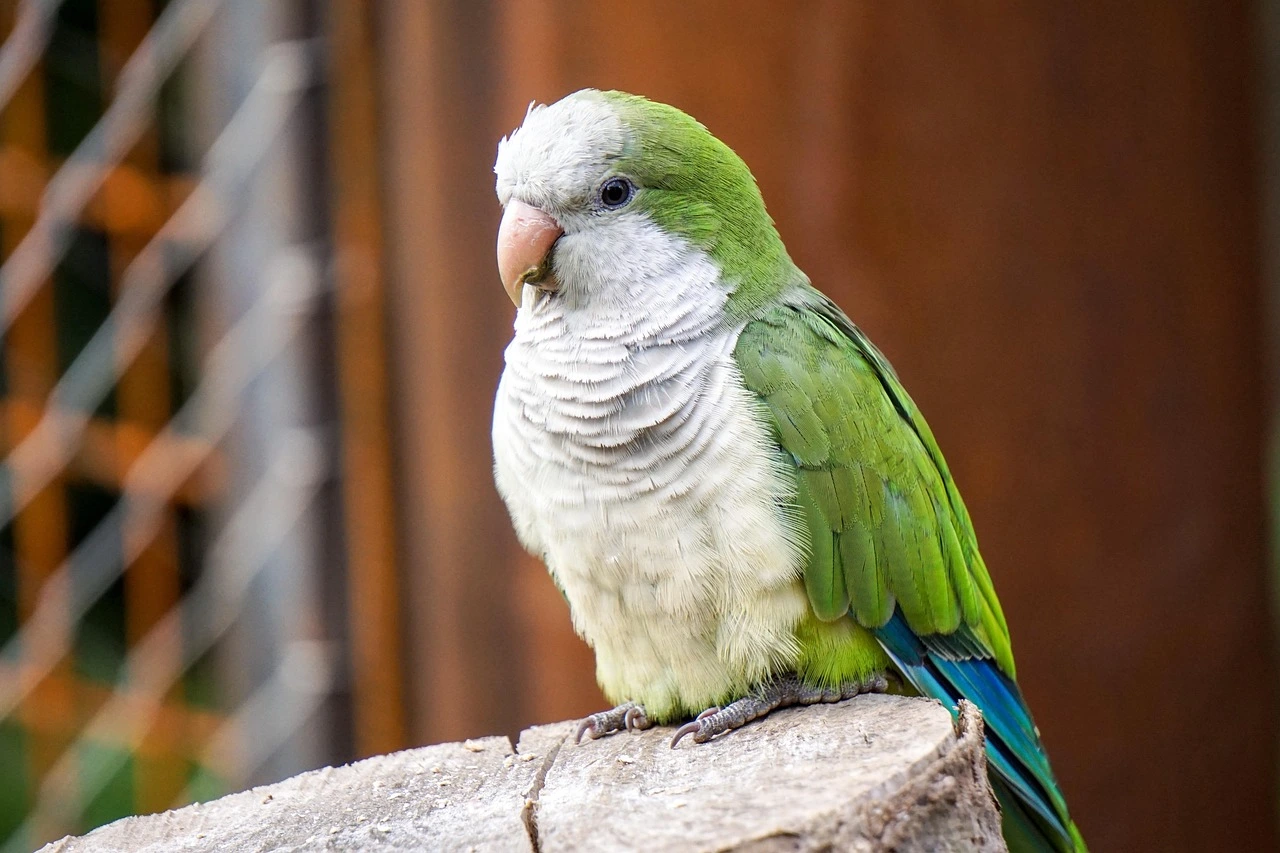
Table of Contents
What is a Quaker Parrot?
The Quaker Parrot (Myiopsitta monachus), also known as the Monk Parakeet, is a medium-sized parrot native to South America, particularly Argentina, Bolivia, Brazil, and Uruguay. These intelligent and social birds have become increasingly popular as pets due to their charming personalities, vocal abilities, and relatively affordable price compared to other parrot species.
Quaker Parrots typically measure 11-12 inches in length and weigh between 90-120 grams. They have a distinctive green body with gray chest and cheeks, giving them their “quaker” or “monk” nickname, as they appear to be wearing a gray vest. Their natural lifespan ranges from 20-30 years in captivity, meaning that bringing a Quaker Parrot into your home is a long-term commitment.
These birds are known for their exceptional nest-building abilities in the wild, creating large communal structures that can house multiple pairs. This construction skill translates to captivity, where Quaker Parrots often arrange and manipulate items in their cages with remarkable dexterity.
Is a Quaker Parrot Right for You?
Before deciding to bring a Monk Parakeet home, it’s essential to consider whether this species aligns with your lifestyle and expectations.
Pros of Owning a Quaker Parrot:
- Intelligence: Quakers can learn tricks, solve puzzles, and even develop a vocabulary of 40-70 words
- Personality: They’re affectionate, playful, and form strong bonds with their owners
- Size: Their medium size makes them manageable compared to larger parrots
- Affordability: Lower initial cost compared to many other parrot species
- Entertainment: Their antics and vocalizations provide constant entertainment
Cons of Owning a Quaker Parrot:
- Noise level: They can be quite vocal and loud, especially during morning and evening hours
- Legal restrictions: Illegal in some states and countries due to their potential as invasive species
- Mess: Like all parrots, they create dust, feather dander, and scatter food
- Time commitment: Requires hours of interaction daily
- Lifespan: Their long Quaker Parrot lifespan means a 20-30 year commitment
Owner Insight: “My Quaker Parrot, Charlie, has been with me for 15 years. While he requires daily attention and regular cleaning, his affectionate nature and hilarious personality make it all worthwhile. Consider your long-term living situation before committing to a Quaker.” – Maria, Monk Parakeet owner since 2009
Quaker Parrot Care
Housing
Proper housing is crucial for your Monk Parakeet’s physical and mental wellbeing. Despite their medium size, these birds need ample space to move, play, and exercise.
Minimum Cage Requirements:
- At least 24″ W × 24″ D × 30″ H (larger is better)
- Bar spacing no more than 3/4 inch
- Horizontal bars for climbing
- Secure door latches (Quakers are escape artists!)
Cage Placement:
- Away from drafts, direct sunlight, and kitchen fumes
- In a room where the family spends time (they’re social creatures)
- Not directly against a wall (allows for better observation)
- Away from windows where predators (even if just neighborhood cats) might stress them
Essential Cage Accessories:
- Multiple perches of varying diameters (natural wood branches are best)
- Food and water dishes (stainless steel is recommended)
- Toys for chewing, foraging, and mental stimulation
- A cage cover for nighttime
Cleaning Schedule:
- Daily: Replace cage liner, clean food and water dishes
- Weekly: Wipe down perches and toys
- Monthly: Deep clean entire cage, replace any worn items
Diet
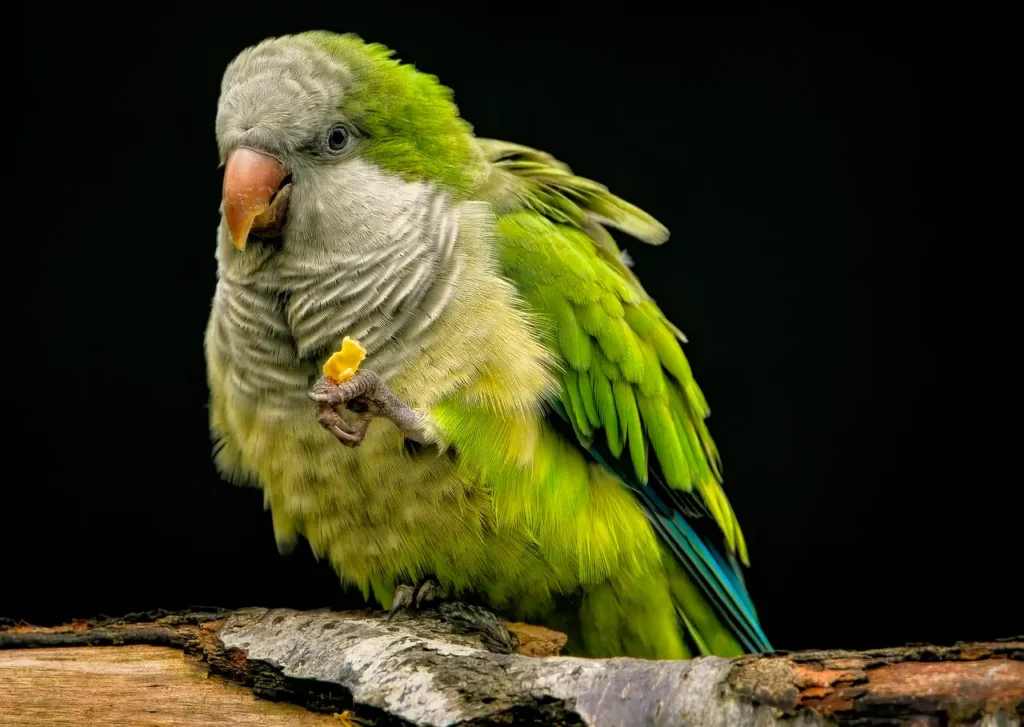
A balanced diet is essential for maintaining your Quaker Parrot’s health and extending their lifespan. Unlike wild Quakers that forage for a variety of foods, captive birds rely entirely on their owners for proper nutrition.
Recommended Diet Breakdown:
| Food Type | Percentage | Examples |
|---|---|---|
| High-quality pellets | 60-70% | Harrison’s, Roudybush, ZuPreem |
| Fresh vegetables | 20-25% | Kale, broccoli, carrots, sweet potatoes |
| Fresh fruits | 5-10% | Apples, berries, melons (limited due to sugar) |
| Healthy seeds/nuts | 5% | Flax seeds, chia, walnuts (occasional treats) |
Foods to Avoid:
- Avocado (toxic to birds)
- Chocolate
- Caffeine
- Alcohol
- High-salt or high-fat foods
- Fruit seeds and pits (especially apple and cherry)
Supplementation:
- Calcium supplement (especially for female birds)
- Vitamin D3 (if bird doesn’t get natural sunlight)
- Consult with an avian vet for specific recommendations
Enrichment
Quaker Parrots are highly intelligent and need regular mental stimulation to prevent boredom and behavioral problems. Enrichment should be a daily part of your Monk Parakeet care routine.
Toy Rotation:
- Provide 3-5 toys in the cage at once
- Rotate toys weekly to maintain interest
- Include various types: shredding toys, puzzles, bells, etc.
Foraging Opportunities:
- Hide treats in foraging toys
- Wrap food in paper for them to unwrap
- Use commercial foraging devices to make eating more engaging
Social Interaction:
- Minimum 2-3 hours outside the cage daily
- Direct interaction with family members
- Consider a second Quaker if you’re away frequently (though introduce carefully)
Grooming
Proper grooming helps maintain your Quaker Parrot’s health and appearance.
Bathing Options:
- Shallow dish of water for splashing
- Gentle misting with room-temperature water
- Commercial bird bathhouses
- Most Quakers should bathe 1-3 times weekly
Nail and Beak Care:
- Provide natural wood perches and cuttlebones to help wear down nails and beaks
- If overgrown, seek professional trimming from an avian vet
- Never attempt to trim wings without proper training
Feather Care:
- Healthy Quakers maintain their feathers through preening
- Provide good nutrition to support healthy feathers
- Watch for signs of feather plucking or abnormal molt
Quaker Parrot Behavior
Typical Behaviors
Understanding normal Monk Parakeet behavior helps you recognize when something might be wrong:
- Chattering: Constant soft vocalizations indicating contentment
- Head bobbing: Often a sign of excitement or wanting attention
- Beak grinding: Usually done before sleeping, indicates relaxation
- Regurgitation: For a bonded human or another bird, a sign of affection
- Nest building: Arranging toys, shredding paper, or building with materials
Understanding Body Language
Quaker Parrots communicate primarily through body language:
- Fluffed feathers: Could indicate relaxation or illness depending on context
- Pinned (dilated) pupils: Excitement or fear
- Raised neck feathers: Aggression or alarm
- Wings held away from body: Overheating or attempting to appear larger
- Tail fanning/wagging: Excitement or displeasure
Managing Problem Behaviors
Biting:
- Usually stems from fear, territorial behavior, or hormonal changes
- Never punish; instead, use positive reinforcement
- Work with a professional if biting becomes habitual
Excessive Screaming:
- Some vocalization is normal, especially morning and evening
- Ensure adequate attention and enrichment
- Don’t reward screaming with attention
Feather Plucking:
- Can indicate medical issues, boredom, or stress
- Requires veterinary assessment
- Environmental enrichment and behavioral modification
Quaker Parrot Training
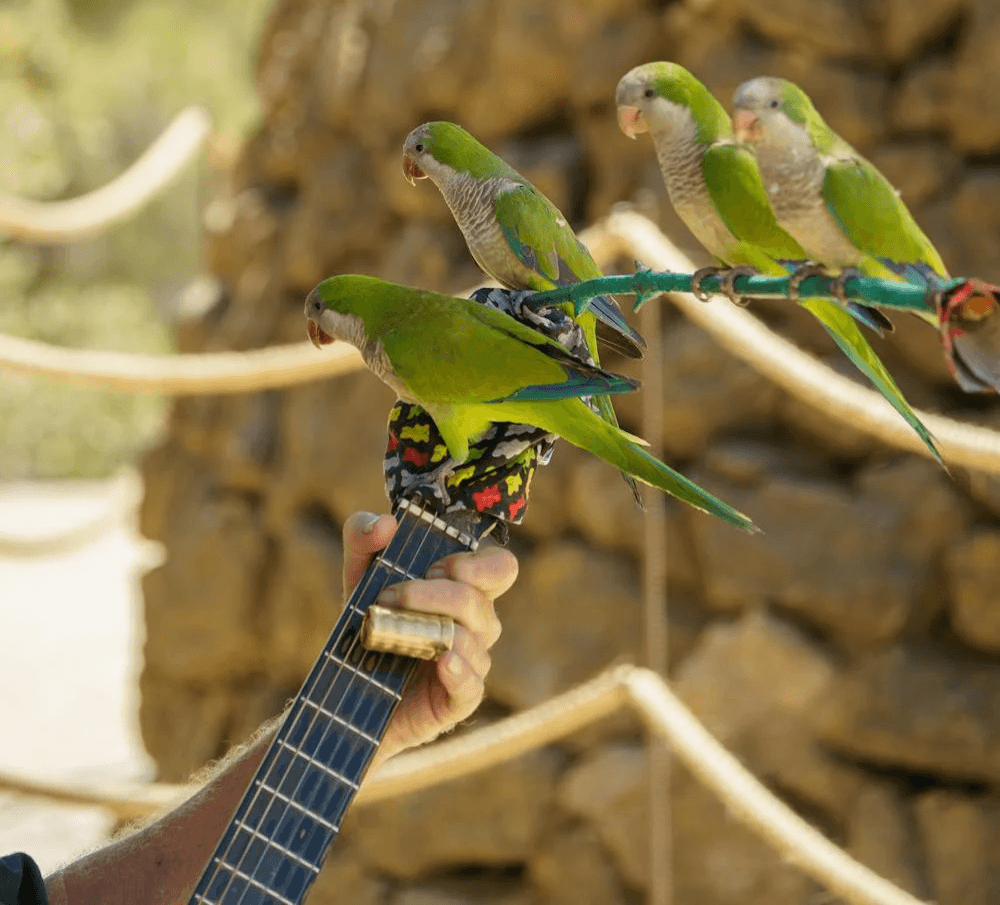
Basic Training Techniques
Monk Parakeets respond well to positive reinforcement training:
- Step-up: Teaching your parrot to step onto your hand
- Offer a perch at chest level
- Use verbal cue “step up”
- Reward immediately with praise and treats
- Practice daily for short sessions
- Target training: Foundation for more complex behaviors
- Use a small stick or chopstick
- Reward bird for touching it with beak
- Gradually shape into following the target
- Recall training: Coming when called
- Start at short distances
- Use consistent verbal cue
- Always reward promptly
Trick Training
Once basic commands are established, Quakers can learn an impressive array of tricks:
- Wave goodbye
- Turn around
- Play dead
- Fetch small objects
- Ring a bell
Potty Training
While not as reliable as dog potty training, many Quakers can be taught preferred elimination locations:
- Observe your bird’s natural timing (typically every 15-20 minutes)
- Create a verbal cue when you notice pre-elimination behaviors
- Hold bird over appropriate area when due for elimination
- Reward success with praise and treats
Quaker Parrot Health
Common Health Problems
Despite their hardiness, Monk Parakeets can experience several health issues:
Respiratory Infections:
- Symptoms: Wheezing, nasal discharge, labored breathing
- Often caused by drafts, poor ventilation, or bacterial infections
Feather Plucking:
- Can be caused by parasites, allergies, boredom, or psychological issues
- Requires veterinary diagnosis to determine cause
Psittacosis (Parrot Fever):
- Bacterial infection that can spread to humans
- Symptoms include lethargy, respiratory issues, and watery droppings
Nutritional Deficiencies:
- Most common in seed-only diets
- Can lead to weakened immune system, feather problems, and reduced lifespan
Preventative Care
Regular Veterinary Checkups:
- Annual examination by an avian veterinarian
- Baseline bloodwork to detect issues early
- Weight monitoring
Home Health Monitoring:
- Weekly weighing (digital gram scale)
- Regular observation of droppings
- Monitoring food and water intake
Recognizing Illness
Early detection of illness is crucial. Contact your vet immediately if you notice:
- Changes in droppings (color, consistency, frequency)
- Decreased appetite or thirst
- Fluffed feathers during the day
- Labored breathing or tail bobbing
- Lethargy or unusual quietness
- Discharge from eyes or nares
Quaker Parrot Talking
Talking Ability
Monk Parakeets are renowned for their talking abilities, often rivaling larger parrot species:
- Most Quakers can learn 40-70 words or phrases
- They can mimic household sounds (phones, alarms, other pets)
- Speech typically begins around 8-12 months of age
- Males tend to be more prolific talkers, but females can talk well too
Teaching Tips
To encourage speech development:
- Start with simple, clear words like “hello” and “goodbye”
- Repeat phrases consistently during daily routines
- Speak in an enthusiastic, slightly higher-pitched voice
- Reward any attempts at mimicry
- Practice in quiet environments without distractions
- Consider recording your training sessions to track progress
Quaker Parrot Mutations
Color Variations
While the wild-type Quaker Parrot displays green body feathers with gray chest and face, several color mutations exist:
Blue Quaker:
- Most common mutation
- Blue replaces green, white or pale gray replaces yellow
Cinnamon Quaker:
- Lighter, brownish-green body
- Often has cinnamon-colored features
Lutino Quaker:
- Bright yellow body with white or cream chest
- Red or pink eyes
Pied Quaker:
- Irregular patches of yellow or white throughout plumage
- Partial or complete lack of normal coloration in certain areas
Albino Quaker:
- All-white plumage
- Red or pink eyes
- More susceptible to health issues
Quaker Parrot Legal Status
The Quaker Parrot’s exceptional adaptation abilities have led to established feral colonies in many areas, resulting in legal restrictions:
States Where Quakers Are Illegal:
- California
- Connecticut
- Georgia
- Hawaii
- Kentucky
- Pennsylvania
- Rhode Island
- Tennessee
- Wyoming
States With Restrictions:
- Colorado, Maine, New York, and others require permits
International Restrictions:
- Banned in Spain, Portugal, and parts of Australia
- Heavily regulated in the UK and Canada
Important: Always check current local regulations before acquiring a Quaker Parrot, as laws change frequently. Illegal ownership can result in confiscation and fines.
Finding a Quaker Parrot
Selecting a Reputable Source
Rescue Organizations:
- Often have Quakers needing homes
- Provides opportunity to help a bird in need
- Usually come with known history and personality assessment
Reputable Breeders:
- Should allow facility visits
- Provide health guarantees
- Demonstrate knowledge about proper bird care
- Offer post-purchase support
Red Flags When Purchasing:
- Very young birds (under 8 weeks)
- Signs of illness (lethargy, discharge, poor feather quality)
- Overcrowded or unsanitary conditions
- Unwillingness to answer questions
- Significantly below-market pricing
What to Look For
When selecting a Quaker Parrot, observe:
- Alert, bright eyes
- Clean nostrils and vent
- Smooth, well-groomed feathers
- Active, curious demeanor
- Steady weight (ask to see records)
- Clean feet and legs
- Willingness to eat in your presence
Quaker Parrot Price and Ongoing Costs
Initial Investment:
- Bird: $250-600 depending on mutation and source
- Cage: $150-300 for appropriate size
- Initial supplies: $100-200 (perches, toys, food dishes)
Ongoing Monthly Costs:
- Quality pellets: $15-25
- Fresh produce: $20-30
- Toys: $15-25 (replacing as destroyed)
- Miscellaneous supplies: $10-20
Annual Expenses:
- Veterinary checkup: $75-150
- Emergency fund contribution: $10-25 monthly recommended
- Total annual cost: $800-1,500
Quaker Parrot Lifespan
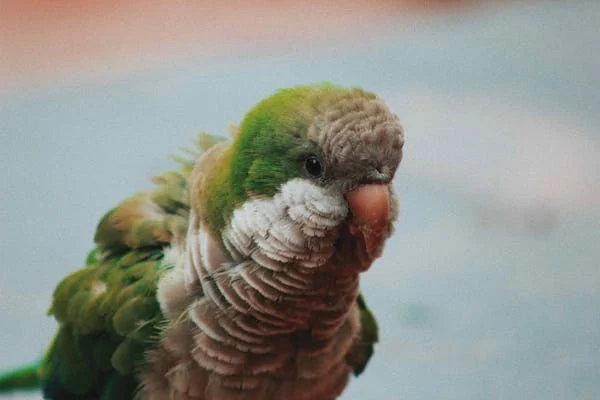
With proper care, Quaker Parrots typically live 20-30 years in captivity. Factors affecting Monk Parakeet lifespan include:
Lifespan Extenders:
- Balanced, nutritious diet
- Regular veterinary care
- Appropriate housing
- Regular exercise and enrichment
- Low-stress environment
Lifespan Reducers:
- Seed-only diets
- Lack of veterinary care
- Exposure to toxins (cigarette smoke, non-stick cookware fumes)
- Inadequate housing
- Isolation or social stress
Conclusion
Quaker Parrots make wonderful companions for the right owners—those willing to commit to their significant care requirements and potential 30-year lifespan. Their intelligence, personality, and talking ability rival much more expensive parrot species, making them an excellent choice for dedicated bird enthusiasts.
Before bringing a Quaker Parrot home, ensure you understand the legal status in your area, have appropriate housing prepared, and are committed to providing the enrichment these intelligent birds require. With proper care and attention, your Monk Parakeet can become a cherished family member offering decades of companionship and entertainment.
Have you considered adding a Quaker Parrot to your family? What aspects of Monk Parakeet care do you find most challenging? Share your experiences or questions in the comments below!

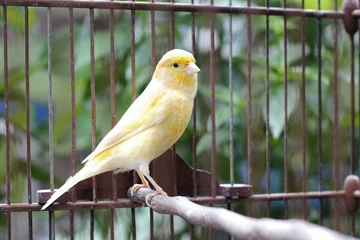
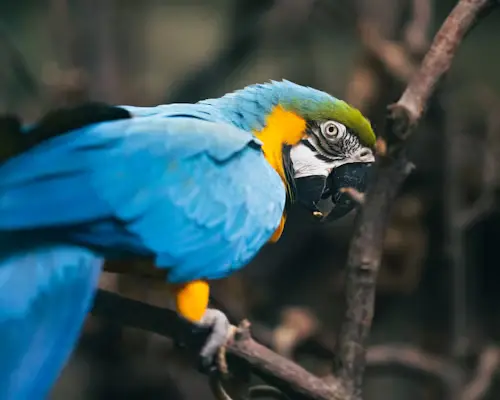
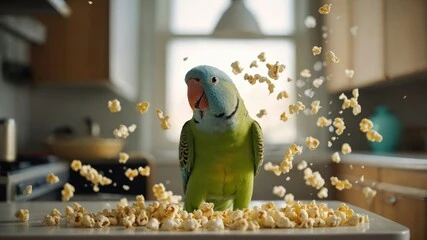

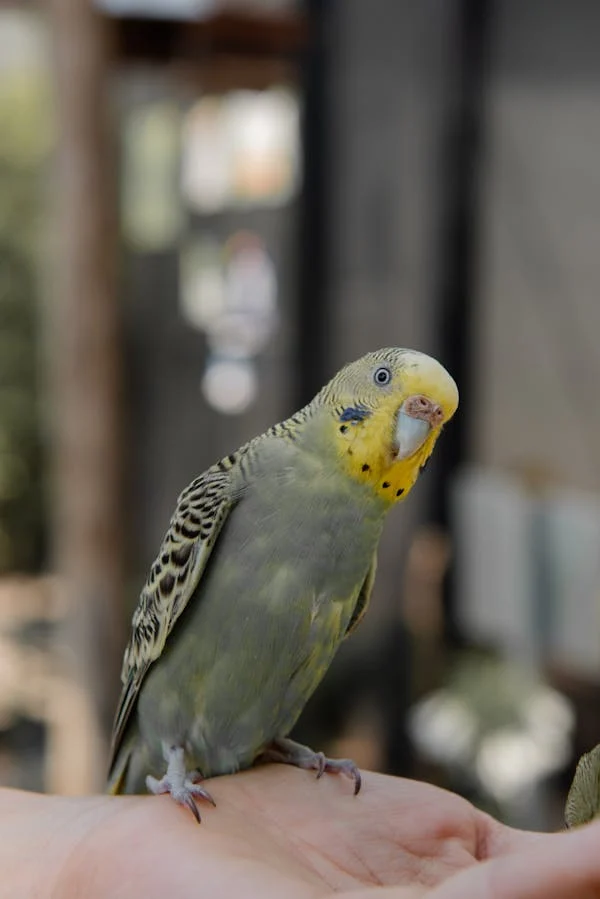

4 Comments